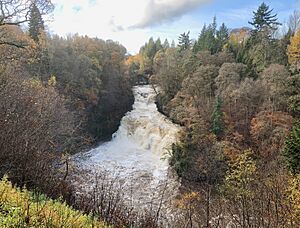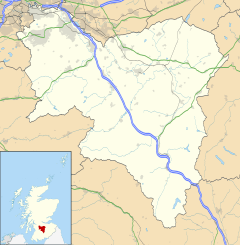Falls of Clyde (waterfalls) facts for kids
Quick facts for kids Falls of Clyde |
|
|---|---|

Corra Linn in full spate
|
|
| Lua error in Module:Infobox_mapframe at line 185: attempt to index field 'wikibase' (a nil value). | |
| Location | New Lanark, South Lanarkshire, Scotland |
| Coordinates | 55°39′12″N 3°46′36″W / 55.65333°N 3.77667°W |
| Total height | 26 m (84 ft) |
| Number of drops | 4 |
| Watercourse | River Clyde |
The Falls of Clyde is the name for four amazing waterfalls on the River Clyde in Scotland. They are close to a village called New Lanark in South Lanarkshire. These four waterfalls are: Bonnington Linn, Corra Linn, Dundaff Linn, and Stonebyres Linn. Corra Linn is the tallest, dropping about 26 m (84 ft).
Bonnington Linn (about 9.1 m (30 ft) high), Corra Linn, and Dundaff Linn (about 3.0 m (10 ft) high) are all found above New Lanark. These three falls are part of the Falls of Clyde Reserve. This reserve is looked after by the Scottish Wildlife Trust, which is a charity that helps protect nature. Stonebyres Linn is a bit further away, downstream from the reserve and New Lanark.
Contents
A Look Back in Time
The Falls of Clyde have always been a popular spot for visitors. Many famous people, like the poets William Wordsworth and Samuel Taylor Coleridge, and writer Sir Walter Scott, came to see them. In 1802, William Wordsworth even wrote a poem about Corra Linn, the biggest waterfall. Many artists, including J. M. W. Turner, have also painted Corra Linn.
Old Buildings and Legends
Near Corra Linn, you can find the Pavilion. Sir John Carmichael of Bonnington built it around 1708. This building had mirrors on its back wall. When the doors opened, visitors felt like they were standing right under the waterfalls!
The old Corra Castle from the 1400s is also next to Corra Linn. Today, many Daubenton's bats, Natterer's bats, and whiskered bats live there. The name 'Corra' might come from a Gaelic word meaning 'marshy place'. There's also a legend that says a princess named Cora, daughter of King Malcolm II, jumped to her death here while trying to escape danger.
You can also see the ruins of Stonebyres Castle from the 1400s near Stonebyres Linn.
Falls of Clyde Nature Reserve
| Falls of Clyde | |
|---|---|
| formerly the Corehouse Nature Reserve | |

The natural amphitheatre at the base of Corra Linn.
|
|
| Location | South Lanarkshire, Scotland, United Kingdom |
| Nearest city | Lanark |
| Established | 1960s: The Corehouse Nature Reserve is established by Colonel Cranstoun of Corehouse 1971: Falls of Clyde is designated a Site of Special Scientific Interest 2007: The Falls of Clyde is amalgamated into the Clyde Valley Woodlands National Nature Reserve |
| Governing body | Scottish Wildlife Trust |
The Falls of Clyde area is a special place for nature. It's called a Site of Special Scientific Interest (SSSI). It's also part of the bigger Clyde Valley Woodlands National Nature Reserve. This area has many different kinds of trees, including old oak woods.
Amazing Animals and Birds
This reserve is home to lots of wildlife. You might spot badgers, roe deer, and over 100 types of birds. It's especially famous for its peregrine falcons. These amazing birds of prey nest here. During their nesting season, a special project called Operation Peregrine helps protect them. It also lets people watch the falcons through telescopes and cameras.
On October 22, 2011, a very rare pine marten was seen and photographed in the reserve. The River Clyde, which flows through the reserve, is also a good home for otters and kingfishers. You can also find the protected brook lamprey, which is a type of fish.
Visitor Centre Fun
The Scottish Wildlife Trust runs the Falls of Clyde Visitor Centre. Here, you can learn all about the waterfalls, the woodlands, and the animals that live there. They even have a special display about bats!
Power from Water
The Falls of Clyde are not just beautiful; they also help make electricity! The Lanark Hydro Electric Scheme uses the power of the water. It's one of the oldest hydro-electric power stations in the United Kingdom.
How Hydro-Electric Power Works
This power station was planned in 1925 and finished in 1927. It was the first hydro-electric power station in Scotland. It takes water from Bonnington Linn and uses it to spin big machines that create electricity. This station makes about eleven megawatts of power.
There's another hydro-electric power station near Stonebyres Linn, about three miles from Corra Linn. This one makes about six megawatts of power. Both of these power stations are owned and run by Scottish Power.
Walking the Clyde Walkway
The Clyde Walkway is a long path that follows the River Clyde. It passes by all four of the Falls of Clyde. The path ends at Bonnington Linn, making it a great way to explore the area and see all the waterfalls.
Photograph gallery
Maps
Annotated map of Lanark, New Lanark and Falls of Clyde













